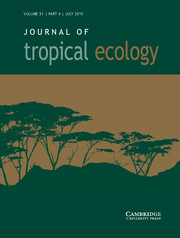Article contents
Pollination syndromes and interaction networks in hummingbird assemblages in El Triunfo Biosphere Reserve, Chiapas, Mexico
Published online by Cambridge University Press: 30 July 2018
Abstract:
Plant–animal mutualistic interactions through ecological network systems and the environmental conditions in which they occur, allow us to understand patterns of species composition and the structure and dynamics of communities. We evaluated whether flower morphologies with different pollination syndromes (ornithophilous and non-ornithophilous) are used by hummingbirds and whether these characteristics affect the structure (core-peripheral species) of hummingbird networks. Observations were made in flowering patches, where plant–hummingbird interactions were recorded at three altitudes (300–2500 m) during three seasons (dry, rainy and post-rainy) from 2015 to 2016 at El Triunfo Biosphere Reserve, Chiapas, Mexico. We recorded 15 hummingbird species interacting with 58 plant species, and the greatest number of interacting hummingbird species (11; 14) and plant species (28; 40) were found at middle altitudes and during the dry season, respectively. In all study sites, most of the plant species visited by hummingbirds had an ornithophilous syndrome (67%) at high altitudes (22 plant species) and during the dry season (26 plant species), but more individual hummingbirds visited non-ornithophilous plant species. The hummingbird species at high altitudes exhibited the greatest level of specialization towards plants (H2′ = 0.74), but the networks of plant-hummingbird interactions were generalist (H2′ = 0.25); i.e. visiting plants with both syndromes, at low altitudes. The core generalist hummingbird species remained constant with altitude and season, but the core generalist plant species varied between different altitudes and seasons according to the phenology of the species.
Keywords
- Type
- Research Article
- Information
- Copyright
- Copyright © Cambridge University Press 2018
References
LITERATURE CITED
- 8
- Cited by




